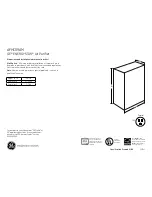
24
6.5
Vacuuming and Refrigerant Charging & Discharging Process
Vacuuming of the system is very important in terms of performance in cooling systems. During the installation process or if the
system is switched on, it must be vacuumed. Air and moisture in the refrigeration system have undesirable effects as indicated
below:
•
Pressure in the system rises.
•
Operating current rises.
• Cooling or heating (only for models with heating function) efficiency drops.
•
Moisture in the refrigerant circuit may freeze and block capillary tubing.
•
Water may lead to corrosion of parts in the refrigeration system.
Therefore, pipe installation between the indoor and outdoor unit must apply leakage test and be evacuated to remove any non
condensables and moisture from the system.
Vacuum operation should be done with a high quality vacuum pump.
Check that each tube (both liquid and gas side tubes) between the indoor and outdoor units have been properly connected and
all wiring for the test run has been completed. Remove the service valve caps from both the gas and the liquid side on the outdoor
unit.
Note that both the liquid and the gas side service valves on the outdoor unit are kept closed at this stage.
1.
When relocating the unit to another place, perform evacuation using vacuum pump.
2.
Make sure the refrigerant added into the air conditioner is in liquid form in any case.
3.
Oil trap should be installed every 5m (no oil trap needed when outdoor unit installed at a lower place than indoor unit).
Vacuuming Application
1.
For cooling (summer), the low pressure line (blue hose) is connected to the 3-way (turn) valve of the outdoor unit. Tighten the flare
nut.
2.
For heating (winter) the high pressure line (red hose) is connected to the 3-way (turn) valve of the outdoor unit. Tighten the flare
nut.
3.
Open the valve of the low pressure side of manifold gauge counter-clockwise
4.
The vacuum pump is switched on. System start vacuuming by opening manifold low pressure line valve and system valve.
5.
Vacuuming continue for 10 minutes until the precise vacuum clock falling to zero (0).
6.
Close the valve of the low pressure side of manifold gauge clock side. Then vacuum pump is switched off.
7.
Remove the hose of the low pressure side of manifold gauge.
8.
After the vacuum process is completed, a precise vacuum manometer is observed for 5 minutes.
9.
Make sure the pressure display in the pressure indicator is a little higher than the atmospheric pressure. This procedure verifies if
the refrigerant goes through the tubes correctly.
10.
The rise of the pointer on the vacuum clock indicates leakage in the system. In this case, it is necessary to check the system for
leakage.
11.
Check for gas leakage.
12.
At this time, especially check for gas leakage from the 3-way valve’s stem nuts, and from the service port cap.
13.
If there is no leakage, the valve on the 2-way (pressure) valve on the unit is opened with the allen wrench and the refrigerant in
the outdoor unit is supplied to the system.
14.
The return valve is opened and the system is made ready for operation.
Pump Down
When relocating or disposing of the air conditioner, pump down the system following the procedure below so that no refrigerant is
released into the atmosphere.
•
Connect the hose of manifold valve to the charge port of stop valve on the gas pipe side of the outdoor unit.
•
Close the stop valve on the gas pipe side almost completely.
•
Fully close the stop valve on the liquid pipe side.
•
Turn on the unit in COOL mode.
•
Fully close the stop valve on the gas pipe side when the pressure gauge shows 1 - 0.5 kgf/cm2 (100 ~ 50 kPa)
•
Stop the test run operation by turn the unit off and all the refrigerant gas have been collected in the outdoor unit.
Refrigerant Refill
For the R410A refrigerant, can not be added into the system before it is completely discharged from system.
•
Purge air. (for new installation only)
• Turn the 3-way valve clockwise to close, connect the pressure gauge (low pressure side) to the service valve, and open the
3-way valve again.
• Connect the tank to refill with Refrigerant.
•
Set the unit to cool operation mode.
Summary of Contents for ZS12V70CCHI
Page 1: ...EN Service Manual Split Type Air Conditioner ...
Page 61: ...EN ...
















































